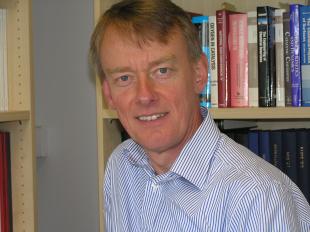Prof Ian S Metcalfe obtained his first degree in chemical engineering from Imperial College where he was awarded the Hinchley Medal. He then performed his graduate study at Princeton University obtaining his MA in 1984 and his PhD in 1987. He returned to the UK to take up a position as a Lecturer and later Senior Lecturer at Imperial College. In 1997 he was appointed to the Chair of Chemical Engineering at the University of Edinburgh and in 2001 he became Professor of Chemical Engineering at UMIST. In 2005 he moved to Newcastle University as the Professor of Chemical Engineering. Ian is a Fellow of the Institution of Chemical Engineers and a Fellow of the Royal Society of Chemistry. He was elected a Fellow of the Royal Academy of Engineering in 2012. He has held both an Esso Centenary Education Award (1989) and an ICI Fellowship (1993). Whilst at Imperial College he received the Imperial College Award for Excellence in Teaching (1996). He currently holds a European Research Council Advanced Grant and acts as director of the virtual UK membrane centre (EPSRC – SynFabFun). He has authored a textbook on chemical reaction engineering which has sold 10 000 copies and has published more than 130 refereed research articles. He has supervised 50 PhD students. His research is in the area of the thermodynamics of chemical conversion with an emphasis on energy processes. He has a particular interest in membrane processes and solid-gas chemical looping cycles.
Keynote (Inorganic Membranes)
Ion-conducting inorganic membranes for a sustainable future
Ian S Metcalfe
Chemical Engineering and Advanced Materials, Newcastle University, Newcastle upon Tyne, NE1 7RU, UK
Membranes and membrane reactors are of great interest in the chemical industries because they offer the possibility of improved yields and more compact plant. Clearly the availability of membrane systems having suitable performance at an acceptable cost is an important consideration. Organic membranes can be difficult to use at high temperatures, while porous inorganic membranes tend to have problems associated with selectivity. In this talk we will focus on the use of inorganic, dense, ion-conducting membranes. Such membranes can be highly selective.
Mixed ionic and electronic (MIEC) conducting metal oxides can be employed as oxygen permeable membranes (in the case of coupled oxygen ion and electron transport) or hydrogen permeable membranes (in the case of coupled proton and electron transport). We will discuss the process application of MIEC membranes. We will also look at current research work on e.g. developing sulfur-tolerant membranes for hydrocarbon reforming applications and hydrogen production. We have demonstrated an enhanced sulfur-tolerance of La0.6Sr0.4Co0.2Fe0.8O3- (LSCF) MIEC membranes by growing an alumina (AlOx) nanofilm on their surfaces using atomic layer deposition (ALD). ALD is known for its high quality and conformal film deposition with atomic-scale uniformity. A 30 nm alumina film (30nm-ALD-LSCF) showed a limited sacrifice of oxygen permeation: less than 15% decrease compared to the permeation rate of the bare LSCF membrane before sulfur exposure. Furthermore the ALD modification conferred a protective effect on the membrane.
Rather than design a membrane to have electronic conductivity and ionic conductivity for one specific ion we can design membranes to have conductive pathways for multiple ions. The possibility of combining multiple ionic pathways within the membrane gives added flexibility for membrane design. So, e.g., carbon dioxide permeation can be achieved through the counter diffusion of oxygen ions and carbonate ions in an oxide-supported molten carbonate membrane. Such a membrane has previously been investigated by Lin et al (1) and Lackner et al (2). Dual ion conducting materials have also been employed for the permeation of water (3) and nitrogen oxides (4). We will discuss the process applications of such membranes.
Such membranes would be employed in novel processes such as the ‘uphill’ permeation of CO2. The capture of CO2 from dilute sources, either flue gases or directly from air, incurs significant energetic and economic penalties. This is fundamentally due to the requirement of preparing a concentrated CO2 stream from a dilute stream; transporting CO2 against its own chemical potential gradient, viz. “uphill” transport of CO2. There are very few examples of membranes capable of “uphill” gaseous permeation; dual phase molten salt-ceramic membranes are one, with interesting transport properties in both the molten salt and ceramic support. Coupling CO2 transport with another gas, preferably easily separable and widely available itself, could provide far more cost-effective separation in this “uphill” scenario. Using a novel leak-free membrane geometry, we develop coupled “uphill” transport using only the molten salt component of the membrane. We present “uphill” permeation of CO2 from dilute streams and thoroughly investigate the permeation characteristics. Combined experimental and computational investigations are beginning to develop mechanistic insights based largely on thermodynamic considerations of the molten salt.
Furthermore, we present a wholly new method of measuring permeation rates, by optically visualising the effect of permeation on molten salts confined to a single pore. We compare single pore data with a novel tubular membrane geometry, providing two comparable leak free systems with well-defined chemical potential gradients across the membrane. Both membrane structures are prepared by microfabrication methods that allow unprecedented control over pore geometry. The combination of microfabrication and visualisation allows us to determine fluxes at low driving forces unobtainable in conventional membrane experiments due to limitations with analytical equipment and the impact of leaks. We will show how the use of such low driving forces is critical in understanding both membrane behaviour and performing rigorous membrane design
References
1. B. Lu, Y. S. Lin, J. Membr. Sci., 444, 402 (2013).
2. J. L. Wade, C. Lee, A. C. West, K. S. Lackner, J. Membr. Sci., 369, 20 (2011).
3. W. Suksamai, I.S. Metcalfe, Solid State Ionics 178, 627 (2007).
4. G. Zhang, E. I. Papaioannou, I. S. Metcalfe, Energy Environ. Sci. 8, 1220 (2015).



